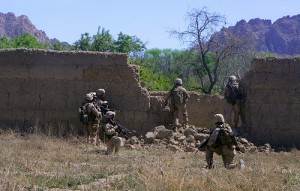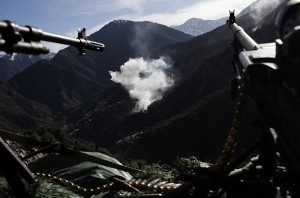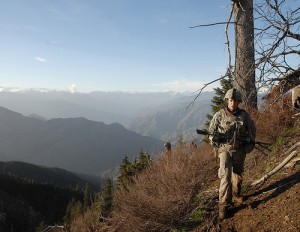At his confirmation hearings as the new commander in Afghanistan two weeks ago, General Stanley McChrystal said reducing civilian deaths from air strikes in Afghanistan was “strategically decisive” and declared his “willingness to operate in ways that minimize casualties or damage, even when it makes our task more difficult”.
Some McChrystal supporters hope he will rein in the main source of civilian casualties: Special Operations Forces (SOF) units that carry out targeted strikes against suspected “Taliban” on the basis of doubtful intelligence and raids that require air strikes when they get into trouble.
But there are growing indications that his command is preparing to deal with the issue primarily by seeking to shift the blame to the Taliban through more and better propaganda operations and by using more high-tech drone intelligence aircraft to increase battlefield surveillance rather than by curbing the main direct cause of civilian casualties.
United States officials at a North Atlantic Treaty Organization (NATO) conference in Brussels last Friday told reporters that “public relations” were now considered “crucial” to “turning the tide” in Afghanistan, according to an Agence-France Presse story on June 12.
Central Command chief General David Petraeus also referred to the importance of taking the propaganda offensive in a presentation to the pro-military think-tank the Center for a New American Security (CNAS) on June 11. “When you’re dealing with the press,” he said, “when you’re dealing with the tribal leaders, when you’re dealing with host nations … you got to beat the bad guys to the headlines.”
The new emphasis on more aggressive public relations appears to respond to demands from US military commanders in Afghanistan to wrest control of the issue of civilian casualties from the Taliban. In a discussion of that issue at the same conference, General David Barno, the commander of US forces in Afghanistan from 2003 to 2005, said, “We’ve got to be careful about who controls the narrative on civilian casualties.”
United States military commanders in Afghanistan “see the enemy seeking to take air strikes off the table” by exaggerating civilian casualties, Barno said. He objected to making civilian casualties an indicator of success or failure, as a CNAS paper has recommended.
The US command in Afghanistan has already tried, in fact, to apply “information war” techniques in an effort to control the narrative on the issue. The command has argued both that the Taliban were responsible for the massive civilians casualties in a US air strike on May 4 that killed 147 civilians, including 90 women and children, and that the number of civilian deaths claimed has been vastly exaggerated, despite detailed evidence from village residents supporting the casualty figures.
Colonel Greg Julian, the command’s spokesman, said in late May that a “weapon-sight” video would show that the Taliban were to blame. However, Nancy A Youssef reported on June 15 in McClatchy newspapers that the video in question showed that no one had checked to see if women and children were in the building before it was bombed, according to two US military officials.
The Afghan government has highlighted the problem of SOF units carrying out raids that result in air strikes against civilian targets. Kai Eide, the chief of the United Nations mission in Afghanistan, has now publicly supported that position, saying in a video conference call from Kabul to NATO defense ministers meeting in Brussels on June 12 that there is an “urgent need” to review raids by SOF units, because the civilian casualties being created have been “disproportionate to the military gains”.
But McChrystal hinted in his confirmation hearing that he hoped to reduce civilian casualties by obtaining more intelligence, surveillance and reconnaissance aircraft. Petraeus confirmed that approach to the problem in remarks at the CNAS conference last week, announcing that he was planning to shift some high-tech intelligence vehicles from Iraq to Afghanistan.
Petraeus referred to “predators, armed full motion video with Hellfire missiles”, “special intelligence birds”, and unmanned intelligence vehicles called Shadows and Ravens, which fly 24 hours a day.
Although such intelligence aircraft may make US battlefield targeting more precise, Petraeus’ reference to drones equipped with Hellfire missiles suggests that US forces in Afghanistan may now rely more than previously on drone strikes against suspected Afghan insurgents. Given the severe lack of accurate intelligence on the identity of insurgent leaders, that would tend to increase civilian casualties.
Petraeus’ past reluctance to stop or dramatically reduce such SOF operations, despite the bad publicity surrounding them, suggests that high level intra-military politics are involved.
The Marine Corps Special Operations Command (MarSOC) has been involved in the most highly publicized cases of massive civilian casualties in Afghanistan. MarSOC was only established by the Marine Corps in February 2006 and the first company arrived in Afghanistan just a year later.
MarSOC was unable to recruit the more mature officers and troops needed for cross-cultural situations, and its recruits had only a few months of training before being sent to Afghanistan.
The unit’s commanding officer had been warned by one participant in the training before the unit had arrived in Afghanistan that his troops were too young and too oriented toward killing to serve in Afghanistan, according to Chris Mason, a former US official in Afghanistan familiar with the unit’s history.
In March 2007, a company of MarSOC troops which had only arrived in the country the previous month were accused of firing indiscriminately at pedestrians and cars as they sped away from a suicide bomb attack, killing as many as 19 Afghan civilians. Five days later the same unit reportedly fired on traffic again.
As a result, a powerful Pashtun tribe, the Shinwari, demanded to the governor of Nangahar province and Afghan President Hamid Karzai that US military operations in the province be terminated. Within a month, the 120-man MarSOC company was pulled out of Afghanistan.
Significantly, however, a new MarSOC unit was sent back to Afghanistan only a few weeks later, assigned to Herat province. Last August, a MarSOC unit launched an attack against a preplanned target in Azizabad that combined unmanned drones, attack helicopters and a Spectre gunship. More than 90 civilians were killed in the attack, including 60 children, but not a single Taliban fighter was killed, according to Afghan and UN officials.
Karzai said the operation had been triggered by false information given by the leader of a rival tribe, and no US official contradicted him.
When Petraeus took command at CENTCOM just a few weeks later, Afghans were still seething over the Azizabad massacre. That would have been the perfect time for him to take decisive action on MarSOC’s operations.
But Petraeus took no action on MarSOC. Meanwhile, other SOF units were continuing to carry out raids that did not get headlines but which regularly killed women and children, stirring more Afghan anger. Petraeus may have been confronted with the necessity of stopping all the operations if he wished to discipline MarSOC, which would have been too serious a blow to the reputation of US Special Operations Forces.
For two weeks, from mid-February to early March, the rate of SOF raids was reduced. But in early March, they were resumed, despite the near certainty that there would be more embarrassing incidents involving SOF operations. The worst case of massive civilian deaths in the war would come just two months later, and involved the MarSOC unit.
Right up front let’s deal with the issue of casualties caused by SOF raids – again. The Captain’s Journal is generally opposed to high value target raids since an insurgency must be defeated from the bottom up rather than the top down. The HVT campaign has been a remarkable failure, and should serve as a lesson in military doctrine and strategy classes for the foreseeable future. We warned you years ago.
But this is not the same thing as saying that casualties – unintended casualties, counterproductive casualties – won’t occur regardless of the tactics being used. Cessation of the SOF high value target campaign won’t end unintended casualties. Either Porter’s argument is a non sequitur, or he knows this and he is simply being dishonest. So he’s either stupid or a liar.
All one must do to understand that the limited force size requires other tactics to prevent U.S. forces from being overrun is read Taliban Tactics: Massing of Troops (you won’t find this kind of analysis anywhere on the web, which is why it is still up as a featured article). TCJ has opposed the separation of Force Recon into MARSOC, believing that it is better for the Corps in particular to keep them attached to infantry. The same goes for Army SOF and Army infantry. They should be re-attached.
But while we have been critical of SOF and their use, Porter is mistaken if he believes that we will turn on McChrystal and SOF when he charges McChrystal with dealing with the issue of civilian casualties “primarily by seeking to shift the blame to the Taliban through more and better propaganda operations and by using more high-tech drone intelligence aircraft to increase battlefield surveillance rather than by curbing the main direct cause of civilian casualties.”
This is stupid, and in a single article Porter has penned a hit job on McChrystal, U.S. air power, U.S. special operations forces, and especially MARSOC (of which he knows absolutely nothing). Frankly, The Captain’s Journal doesn’t appreciate it one bit. Furthermore, his radical bias leads him to miss the point, a point that was well taken and which would have been a worthwhile article had he drawn this point out and done some investigative labor. He started well. It didn’t take him long to crash and burn.
The U.S. is poor when it comes to releasing information, even information that demonstrates that enemy propaganda is false. It’s OPSEC, or it’s FOUO (for official use only), or it’s has to make its way through a hundred layers of approval to be released. Meanwhile, the enemy has already released their talking points.
We lose. Game over. We must do better at releasing the right information, and we must do it quickly. Time is of the essence. This goes contrary to the bureaucracy inherent in the U.S. military, and it will be a hard change to bring to the institution. Can McChrystal accomplish this? Time will tell. But Porter missed the chance at a good article because he is stolid.






